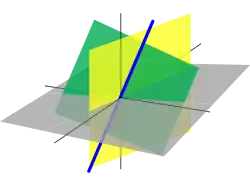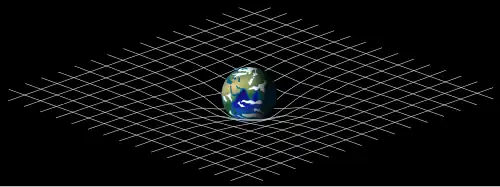Linear algebra

The two planes are subsets of the 3-dimensional space, and their intersection is a line.
Linear algebra is a branch of mathematics that concerns linear equations, vector spaces, linear maps between vector spaces, and matrices.[1]

This affine plane is generated by two vectors and and consists of all linear combinations
Featured Projects
We have three featured projects, both outside the namespace of this resource.
- Mathematics for Applied Sciences (Osnabrück 2023-2024)/Part I is a mathematical course for beginners at the University of Osnabrück. It covers logical foundation, sets, mappings, algebraic structures like fields and polynomials, the basics of analysis like sequences, continuity, differentiability, primitive functions and the basics of linear algebra like vector spaces, bases, linear maps, eigenvalues. While course has been taught many times, this is a textbook -- not an online course.

Ricci calculus is hard to learn, but it will bend your mind!
- Tensors employs the "unorthodox" approach of using the covariant and contravariant forms associated with Ricci calculus. But keep in mind that this approach is vastly superior. It is required for General Relativity, and is the most powerful way to do vectors and tensors.
Other projects
- Introductory definitions is a short and simple introduction to linear algebra. The best part is the three links to three Youtube videos:
- Linear equations is a beginners guide to equations like the famous y=mx+b. In the US, this material is typically introduced in late middle school or early high school.
- Determinant quiz is a 3-question quiz on finding the determinants of square matrices. We need more quizzes on linear algebra. Teachers are encouraged to task students with writing and publishing quizzes on Wikiversity (see the Call for contributions below.)
- Orthogonal matrix attempts to visualize orthogonality and rotational transformations in non-rigorous fashion.
- Linear maps Defines the linearity relevant to this algebra in recondite mathematical language.
- Convex combination. In convex geometry, a convex combination is a linear combination of points (which can be vectors, scalars, or more generally points in an affine space) where all coefficients are non-negative and sum to 1.tion/]].
- Cramer's rule attempts to simplify what can be found in Wikipedia's w:Cramer's rule, while the attempt is successful, the Wikipedia article is fairly readable. In the US, the rule is typically taught soon after a student completes a year of college-level calculus.
Call for contributions
Enter title that is not already on the list below and start your draft. If you wish to change your title, or have any other questions, visit us at Wikiversity:Colloquium.
Wikiversity can also accept submissions that are pdf files. If you are a teacher and wish to publish your students' wikt:exlemperary work on this or any other page, leave a message at the Wikiversity:Colloquium.
- Subpages
See also
This article is issued from Wikiversity. The text is licensed under Creative Commons - Attribution - Sharealike. Additional terms may apply for the media files.